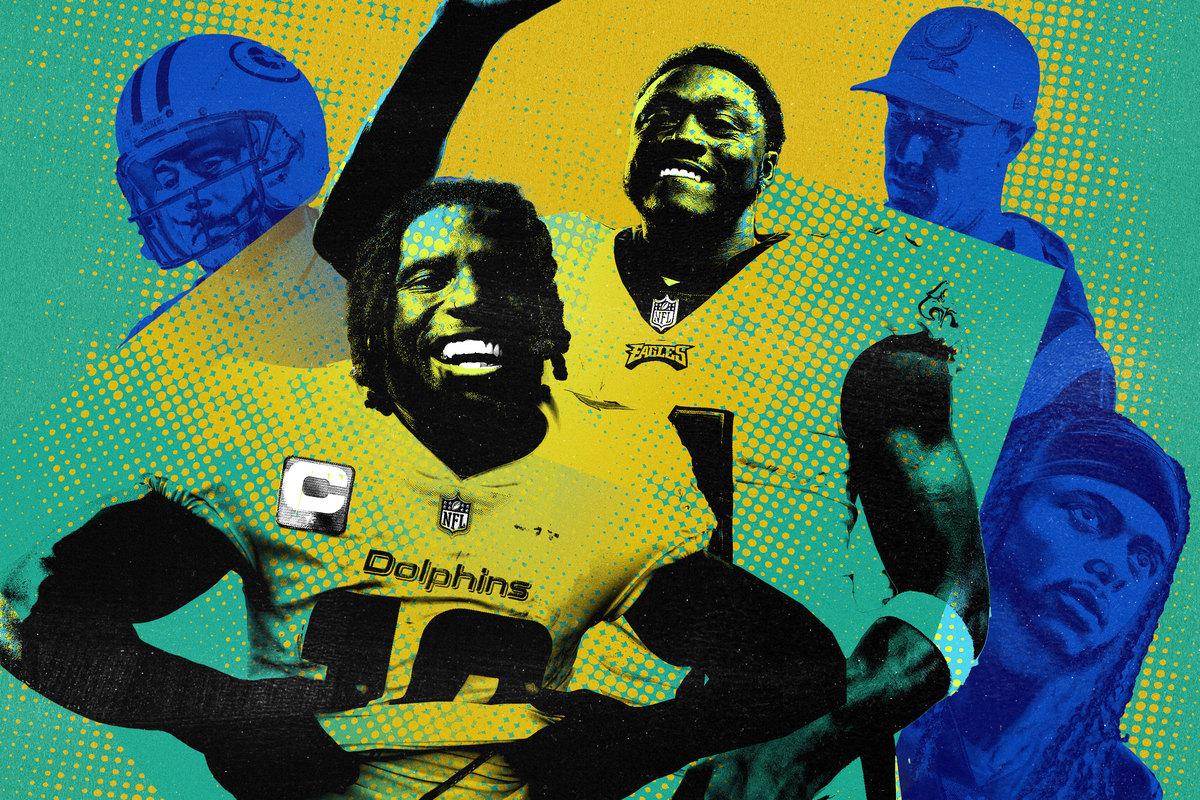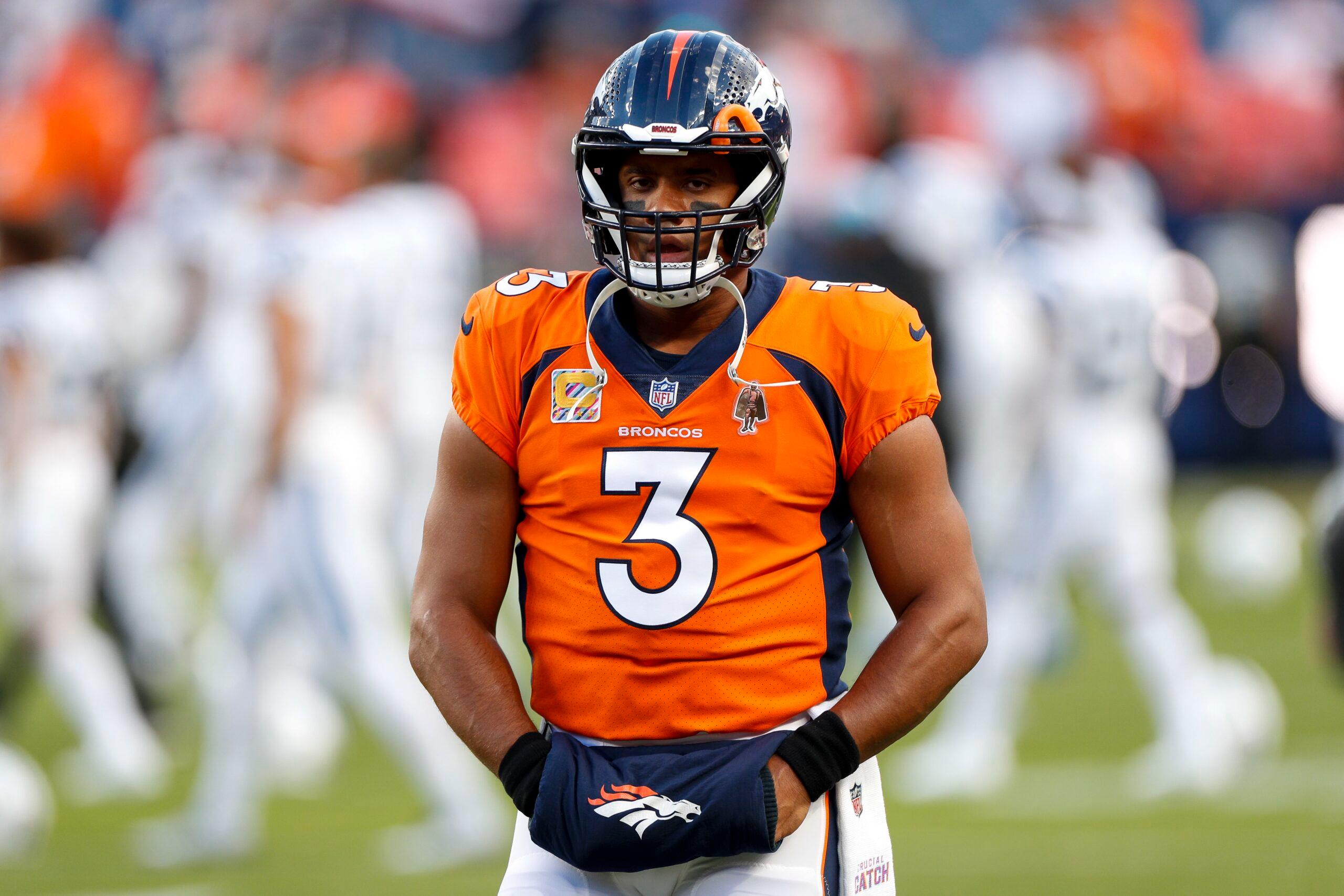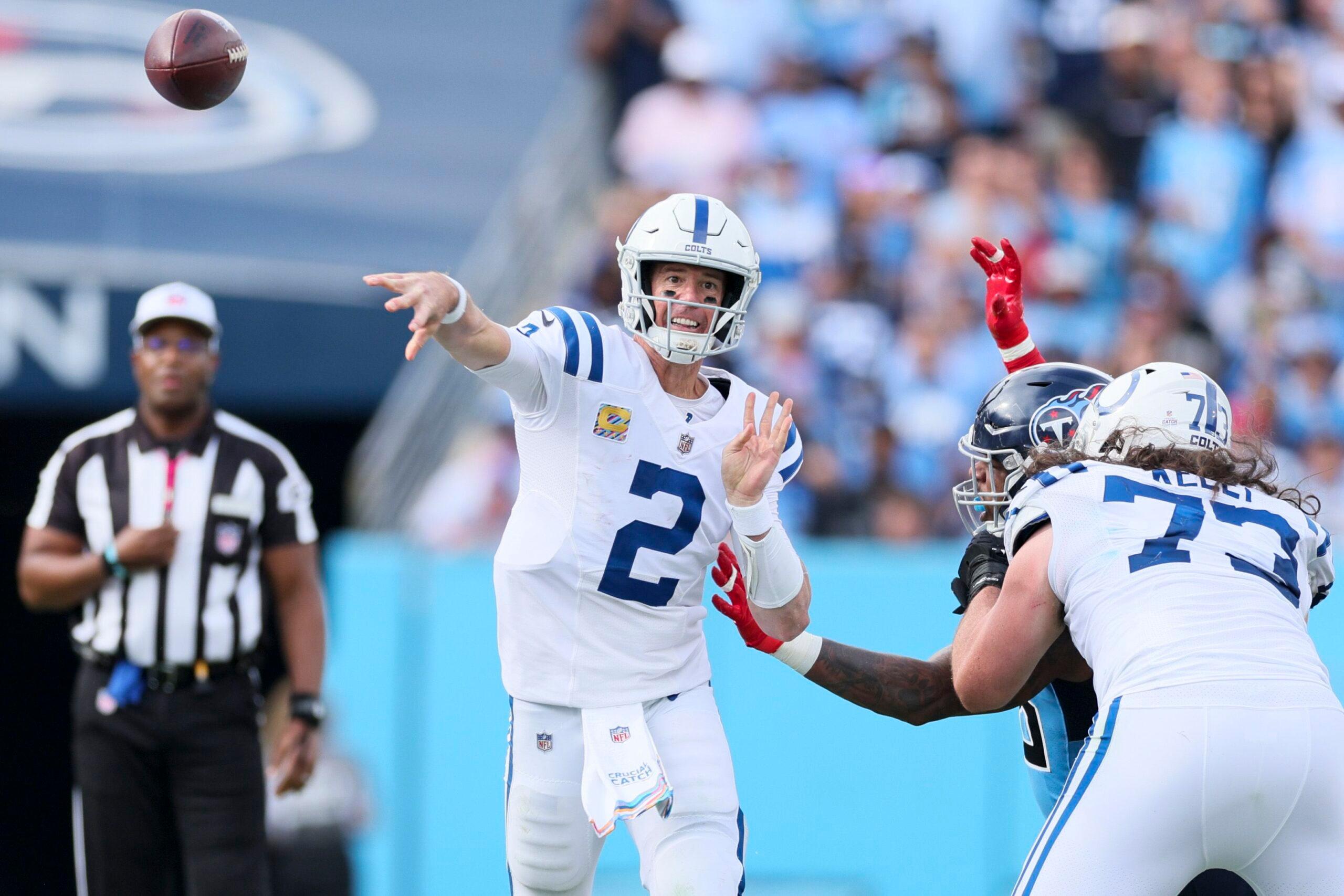
Not too long ago, Indianapolis Colts general manager Chris Ballard was widely viewed as one of the sharpest team-builders in the NFL. Indy didn’t have any major accomplishments to show for it, but Ballard had successfully put together some sustainable, competitive rosters as the franchise went from Andrew Luck to Jacoby Brissett to Philip Rivers to Carson Wentz to Matt Ryan at quarterback. Ballard did this by hoarding draft picks and salary cap space, and mostly avoiding high-risk deals that could have elevated the Colts to legitimate contention.
Over that same time period, the counterbalance to Ballard’s way of doing things has been Rams general manager Les Snead, who is seen as a somewhat reckless wheeler-dealer. His version of roster management—the Rams haven’t made a first-round draft pick since 2016 because of all of his trades for star talent, including one for Jalen Ramsey in 2019 that came in the middle of a lost season—erased all of L.A.’s security nets, and some believed it would eventually sink Sean McVay’s team. You know what happened next: Snead’s risky moves eventually helped the Rams win a Super Bowl, and after a 3-5-1 start this season in which Ryan has been benched for former sixth-round pick Sam Ehlinger and head coach Frank Reich has been fired, Ballard’s seat is getting hotter by the week.
Coming off an offseason that seemed to feature a blockbuster trade every week, it’s safe to say the NFL is starting to think more like Snead and lean toward the “eff them picks” ideology of team-building. That’s not necessarily a surprise. This is famously a copycat league, and its last two champions (the Rams and Buccaneers) won by aggressively stacking their rosters and jeopardizing their future financial and draft stability. Whether the results will ultimately justify the process for this next wave of teams remains to be seen, but after half a season, the returns have started to come in.
The newsmaking trades of the offseason fall into one of two categories: The big swings, which involved first-round picks and superstar talents, and the more low-risk trades, in which recognizable names were swapped for Day 2 picks. That’s how we’ll split them up when evaluating the early results of these deals and declaring the winners and losers of each. Let’s start with the first major move of last offseason: The Broncos trading for Russell Wilson.

The Big Swings
Seattle got: Drew Lock, Shelby Harris, Noah Fant, 2022 first-round pick, 2022 second, 2022 fifth, 2023 first, 2023 second
Denver got: Russell Wilson, 2022 fourth
Yikes. It’s even worse than I remembered. Even if Seattle got nothing in return for Wilson, just not being the team that gave him the “Mahomes money” he was seeking is a major win. Getting back two first-rounders—one has already turned into cornerstone left tackle Charles Cross and the other looks as if it will fall in the top 10—and an additional pair of Day 2 picks makes this one of the most lopsided trades in recent memory. And that’s before considering the players Denver threw in as sweeteners: Shelby Harris has been a useful interior pass rusher, tight end Noah Fant gives the offense more options when drawing up formations and personnel groupings, and Drew Lock is a cheap, talented backup quarterback who should fit the scheme if he’s needed.
There isn’t one aspect of this deal Seattle should regret, even if saving that fourth-rounder would have been pretty sweet. And unless Russell Wilson turns things around (possible!) or that Day 3 pick turns into a franchise-altering player (unlikely!), Denver will probably spend the next few years regretting everything. Maybe my pessimism is too premature, but the main on-field concern right now is that Wilson’s issues seem to be linked, in part, to a physical decline, and that isn’t the sort of thing that gets better with time.
This is a win for Team Stack Resources.
Kansas City got: 2022 first, 2022 second, 2022 fourth, 2023 fourth, 2023 sixth
Miami got: Tyreek Hill
I’m not ready to declare the Chiefs a winner or loser in this one. Trent McDuffie—whom Kansas City used two of Miami’s picks to trade up for and draft—looks like a solid player, but the trade-up also offsets most of the draft capital the Chiefs got in the Hill deal. Of course, Kansas City also got some much needed cap relief: Trading Hill saved about $20.5 million and left behind only a $1.45 million dead cap charge. But the team would have saved a big chunk of that $20.5 million this season if they had just extended Hill instead. He counts for just $6.5 million against Miami’s 2022 cap after the Dolphins gave him a massive extension.
So, really, we’re weighing McDuffie, Kadarius Toney (who probably isn’t on the roster if the team didn’t have extra picks), a little bit of draft capital, and some short-term cap space against a long-term commitment to the best receiver in the NFL right now. Sure, the Chiefs offense is doing just fine without Hill blowing the roof off of defenses, and there’s a definite point of diminishing returns when adding talent to what’s already the best offense in the league. But swapping the superstar speedster in for Marquez Valdes-Scantling would probably make Kansas City the clear Super Bowl favorites. Really, evaluating this trade for Kansas City just depends on the scope you use to view it. In the short term, this team is probably a little worse off than it would have been otherwise. Beyond this season, though, this move will start to look better as Hill ages and the front office starts using the future cap space it saved by not giving him an extension.
Things aren’t so complicated when we evaluate the trade from Miami’s perspective. Hill is on pace to shatter the NFL single-season receiving yardage record, and he’s played such a large role in the success of the offense that he’s starting to get faint whispers of MVP hype. Cooper Kupp is the only receiver to earn a vote for the NFL’s top individual honor in the last quarter-century, so Hill is sprinting on rare ground right now.
Tennessee got: 2022 first, 2022 third
Philadelphia got: A.J. Brown
Like the Kansas City–Miami deal, both participants here are currently at the top of their respective divisions and appear headed for the playoffs. But this one feels a little more one-sided, especially after Tennessee’s loss to the Chiefs on Sunday night, a game in which no Titans receivers caught a pass. Brown, understandably, tweeted out a midseason victory lap at the expense of his former team.
And while Tennessee is keeping its head above water after getting rid of its top receiving option, the team’s 5-3 record is a little fluky. In the AFC alone, there are eight teams with a better point differential, which tends to be a better predictor of future results than wins and losses, including their AFC South rival Jaguars. With two matchups between those teams left on the schedule, the division is still very much up for grabs, and a playoff berth is really the only way Tennessee is going to save face with Brown playing such a pivotal role in Philadelphia’s 8-0 start.
Brown hasn’t really transformed the Eagles’ passing game from a structural and conceptual standpoint; he’s just made the existing one a whole lot better by doing the same things he did in Tennessee: Namely, bullying corners on 50-50 balls downfield and turning short passes into big gains through sheer physicality. Brown is the type of receiver who will win no matter where he lines up before the snap, and no matter where he ends up after it.
This is a clear win for Philadelphia, but Tennessee isn’t coming away empty-handed. Treylon Burks, the Arkansas receiver drafted in the first round last spring, has had a hard time getting on the field but has plenty of talent. The Titans also flipped Philly’s third-rounder for more picks, and used two of them on tackle Nicholas Petit-Frere, a project who is already starting and giving the team valuable run-blocking reps, and corner Roger McCreary, who has been a key cog in Tennessee’s pass-coverage unit. And yet … this team could really use a player like Brown right now. So it’s an L for Tennessee, but it might not be a massive one.
Green Bay got: 2022 first, 2022 second
Las Vegas got: Davante Adams
No matter who or what you choose to blame for this disappointing Green Bay season—Aaron Rodgers’s declining play, inaction from the front office, the underachieving defense and/or the untrustworthy receiving corps—it’s hard to deny that this team, even with Adams still on the roster, was not going to be good enough to compete for a Super Bowl. There are too many issues around the receiver position to say otherwise. So in hindsight, losing Adams a year early, when his trade value was at its highest, was probably for the best. It’s not the W the Packers had in mind when they let Adams go—they tried to keep him, after all—but it’s one they’ll take.
The Raiders, meanwhile, can claim that they added an elite player at one of the sport’s premium positions, but on that roster, Adams is little more than a luxury car parked outside a run-down house. When the new front office reworked Derek Carr’s deal this offseason, they created an obvious path toward a possible teardown and rebuild next year (which is looking awfully tempting after a 2-6 start to the season). That starts with parting ways with the team’s long-standing quarterback—and one of Adams’s close friends. Is the star wideout really going to be content wasting his prime without his hand-picked QB while Mark Davis, Josh McDaniels, and a rookie general manager try to clean up a mess that’s over two decades in the making? As bad as this deal already looks for the Raiders just nine weeks into its first season, things could get a lot messier this spring. Their saving grace is that Adams is still a high-end talent, and if starting over from scratch included putting him on the trade market, they’d probably be able to recoup most of the draft capital they gave up in the deal.
I don’t think either side of this one is thrilled with the results, but it doesn’t appear this will set either franchise back all that much.

The Low-Risk, High-Reward Swings
Atlanta got: 2022 third
Indianapolis got: Matt Ryan
As washed up as Ryan looked before he was benched for Ehlinger, I still don’t believe this trade was a failure in player evaluation. Even during his roughest games, Ryan showed flashes of ability; it was just abundantly clear that he wasn’t capable of elevating a poor supporting cast. More specifically, Ryan couldn’t overcome an offensive line that has significantly regressed over the past two seasons. The failure to find a quarterback who could elevate the roster these past two years ultimately cost Frank Reich his job and sent Jim Irsay down a path to naming an ESPN analyst with three years of high school coaching experience as interim head coach. But this move alone hasn’t really cost the Colts much. If they can trade Ryan in the offseason, even for a meaningless draft pick, they’ll save about $29 million of his $35 million cap hit for 2023. If they can’t, releasing Ryan would save about $17 million.
We can’t give the Falcons too much credit for pulling the plug on the Ryan era—their hand was forced after they tried to land Deshaun Watson and Atlanta’s longtime quarterback asked for a trade. Plus, trading Ryan left behind a $40 million dead cap charge. A third-round pick, which Atlanta used on linebacker DeAngelo Malone, isn’t going to make up for that.
This is a trade with no major winners and no real losers, outside of the Colts coaches who lost their jobs as a result.
Indianapolis got: 2022 second, 2022 third, 2023 conditional pick (second or third)
Washington got: Carson Wentz, 2022 second, 2023 seventh
Whenever there’s a trade involving Wentz, the team that isn’t acquiring him automatically wins. So the Colts, who also managed to save $28.3 million in cap space while moving up in the second round of the 2022 draft, adding a third-round pick (after losing one in the Ryan swap), and picking up a 2023 conditional pick, are the clear winners here.
Washington could salvage the situation (kind of) by keeping Wentz on the bench when he returns from a finger injury a few weeks from now, but there’s no way for the team to rectify it completely. The goal was to bring in a quarterback who would help the Commanders compete for a playoff spot, and Ron Rivera admitted a month ago that the difference between his team and the successful ones in Dallas, Philadelphia, and New York was the quarterback position. Washington’s search for a franchise passer will continue in the offseason, and the team will be down a pair of Day 2 picks during it.
Los Angeles got: Khalil Mack
Chicago got: 2022 second, 2023 sixth
It’s too early to judge this trade from the Chargers’ perspective, as Joey Bosa has missed most of the season and we’ve hardly seen this terrifying pass rushing duo in action. But that should change over the second half. Mack hasn’t been the dominant force he was at his peak, but he’s been the best player on the Chargers defense and has held a weak front seven together almost single-handedly. It’s also not like L.A.’s front office was going to find a more impactful player with that second-round pick—and the financial implications of Mack’s deal aren’t too significant. The Chargers can either move on from him in the offseason, which will save them about $18.4 million with a dead cap hit of $9 million, or they can restructure his deal to bring down his $27.4 million cap hit to a more reasonable price.
But even if Los Angeles gets all of its injured pieces back over the next two months, this still doesn’t feel like the Super Bowl contender the front office thought it was building when it swung the deal. For that reason, this is an L for the Chargers.
For Chicago, though, this looks like a major win for rookie GM Ryan Poles, who has made a number of these cap-clearing moves. The team picked up cap space and immediately turned that second-round pick into safety Jaquan Brisker, who’s already one of the better players on the Bears defense. No matter what happens with the sixth-round pick received in the trade, Poles can count this as an early win in his tenure.
To recap, we have declared five winners out of a possible 14. That’s Seattle, Miami, Philadelphia, Chicago, and Indianapolis (in the Wentz trade). Two of those teams, the Dolphins and Eagles, took massive swings on a star wideout. The others were moving on from important players in exchange for team-building resources. And if we look at the group of obvious losers—Washington, Las Vegas, and Denver—we’ll find teams that gave away draft capital in the hopes of finding a missing piece. All of those deals are failing for different reasons: Wentz has played poorly, Adams is lost on a bad team, and Wilson is somewhere in the middle. So I don’t think we can draw any grand conclusions on the efficacy of pick-for-player trades. When you take a step back and look at other big trades from past years, the split of those that worked out and those that didn’t is mostly even.
But here’s the lesson I’m taking from this exercise: There is no right way to build a football team. If you’re trading picks for a star player, make sure your evaluation of their talent, and your evaluation of your own roster, is accurate. And if you’re looking to flip a star for draft picks, just make sure you’re able to put the draft capital to good use. Oh, and one last lesson: Don’t ever, under any circumstances, trade for Carson Wentz.

